Technical – The Proverbial Second Chance (Backup your stuff!)
The Proverbial Second Chance – Backup Up Your Stuff
Part 1 – Windows Server Backup
Backing up your data, an IT topic that can spawn platitudes for hours. Don’t believe me? “There are 2 types of people in the world, people who have suffered hard drive crashes, and those who will”, “Not having a backup solution is betting your job you will not suffer data loss.” Caro Emerald even wrote a song about it. Click here to watch – Back It Up!.
Okay that one I just made up, but if you enjoyed the music, click bait isn’t necessary a bad thing, right? On a serious note backups are considered part of the C.I.A triangle. NO! not that C.I.A. Remember the C.I.A triangle of security? Confidentiality, Integrity, and Availability? Backups would fall under Availability, if you suffer a hard drive crash, or lose a RAID volume on one of your servers, It will no longer be available. The type of backup, and backup method would determine the duration it is unavailable. If you perform no backups at all, well. Then your data is lost, and will never be available again.
There are many third-party solutions available to perform backups. Some of them like Backula are even free. Most operating system these days provide some method of performing System, database, and file level backup. In this series of blogs we will look at a couple. Both Windows and CentOS Linux. In part 1 we will start with Windows Server Backup which comes with Windows Server.
One thing to also consider is your backup media. As with backup software, the media you choose is a equally important. The tried and true solution is removeable tape such as Quantum’s DTL, or LTO. While tape can be expensive, it has the advantage of the media itself not being mechanical, and able to be read in any device rated for it’s specific tape model. So if you have to rebuild or collocate your servers, The media itself can be read with just replacing the tape drive. A cheaper method is to back it up to an external hard drive, this method is cheap, and in almost every case faster than tape. The problem being is hard drives are mechanical, and sensitive to shock. So if it gets dropped, or otherwise abused removing it from your site. Your backups are useless. Or Murphy being Murphy. The drive will fail to spin up when you need it to, requiring a trip to a data restore company which can end up costing several times more than what a robust tape solution would. Last but now least is cloud backups, these are relatively fast (Faster than tape, slower than hard disk), backups but totally dependent on a reliable network connection, for both a successful backup and data recovery. Taking all of these factors into account I would recommend the tried and true tape method for backups, even though people may laugh and ask why you’re living in the stone age, it is the only method currently that offers you the best chance of successful restore when you need it.
So on to the meat! Let’s start with Windows Server, for this demonstration we are a small business with Windows 2019 Standard Servers, we will be backing up to a a second internal hard disk (Not recommended!)
Step 1- Installing Windows Server Backup
- Open Server Manager
- Click on Manage and select Add Roles and Features
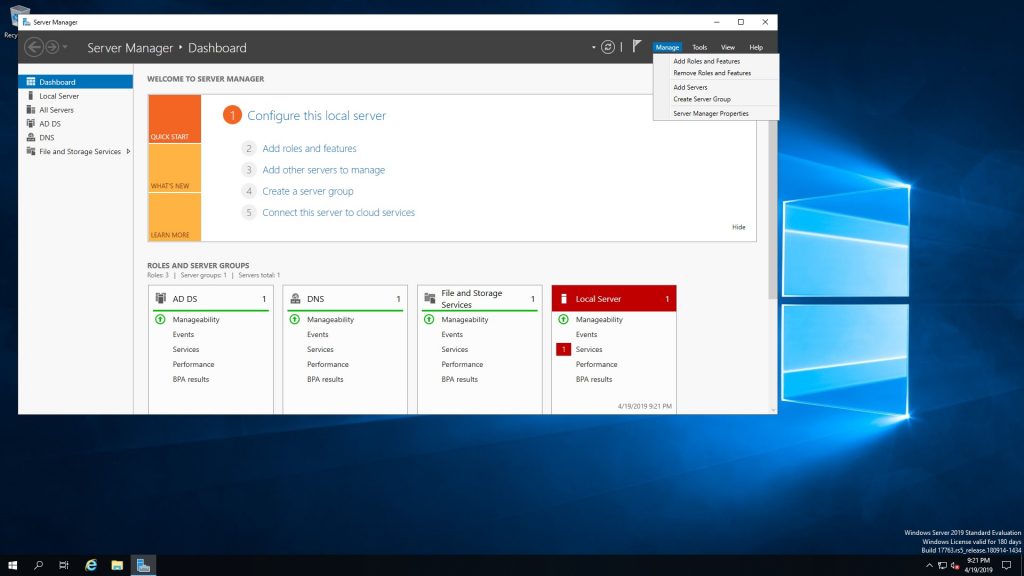
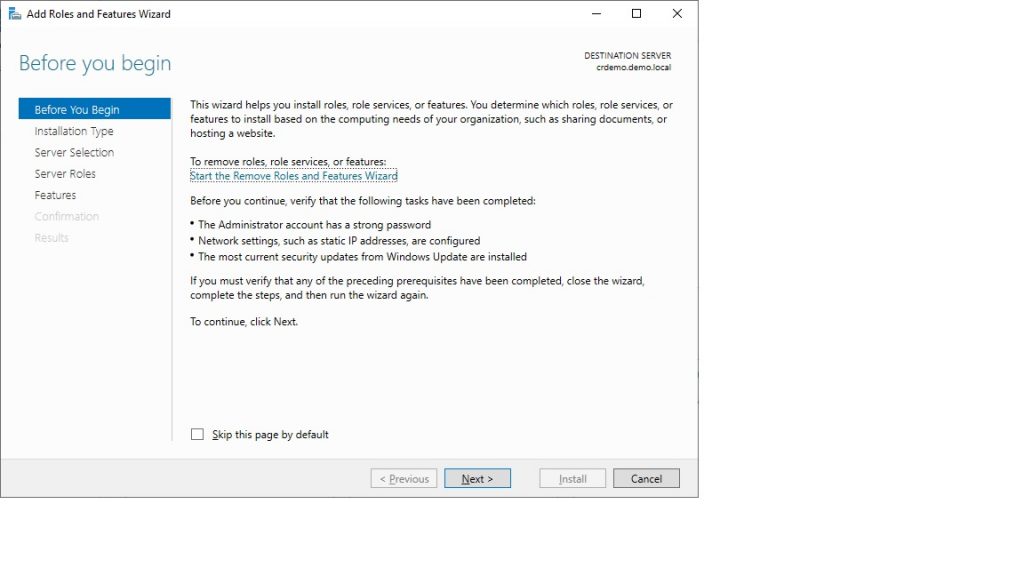
- At the Before you begin screen click Next >
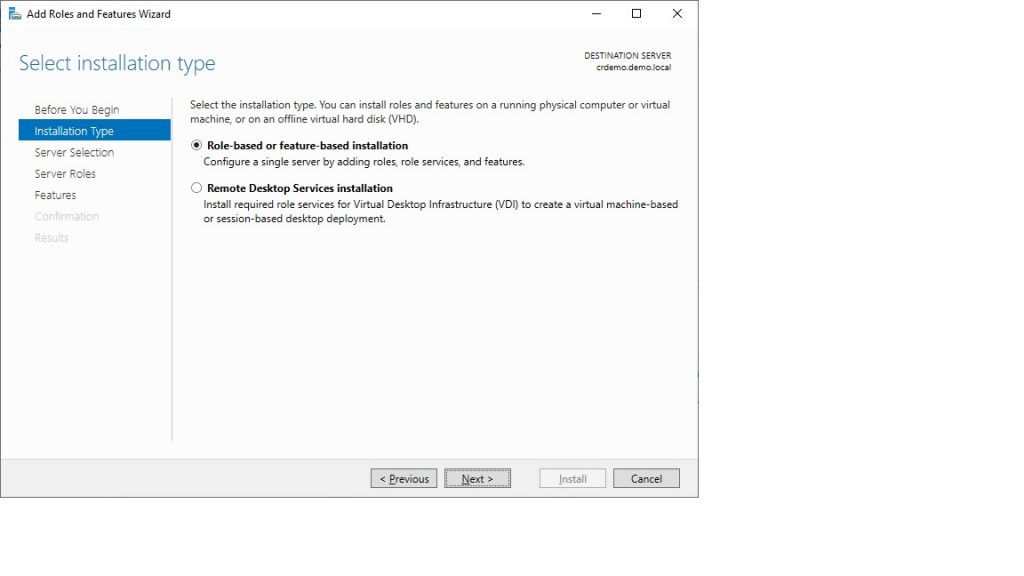
- At the Select installation screen type verify ‘Role based feature-based installation is selected, click Next >
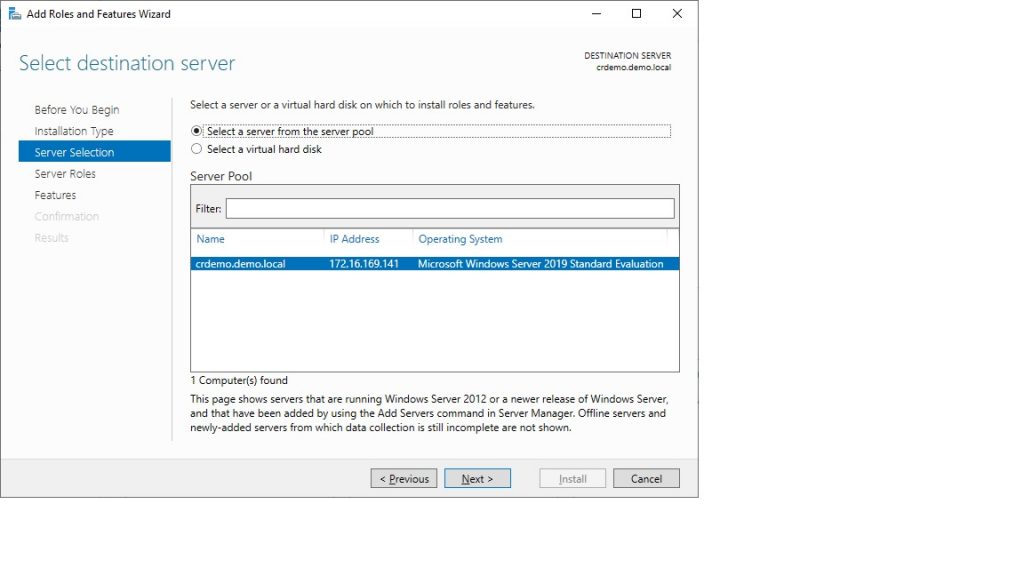
- At the Select destination server, verify the correct server is selected, in still case ‘crdemo.demo.local’ is correct. Click Next >
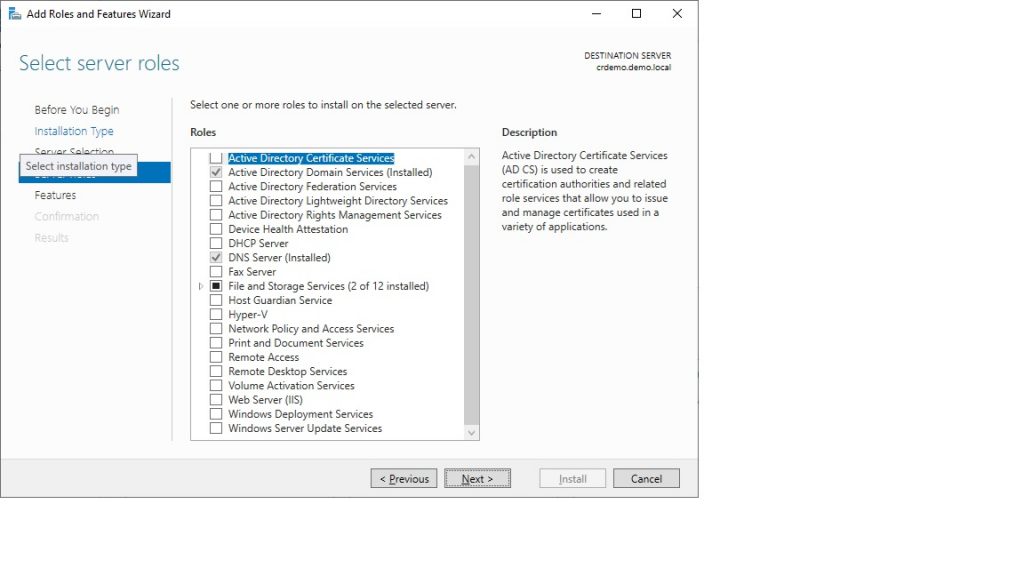
- At the select server roles screen, click Next >
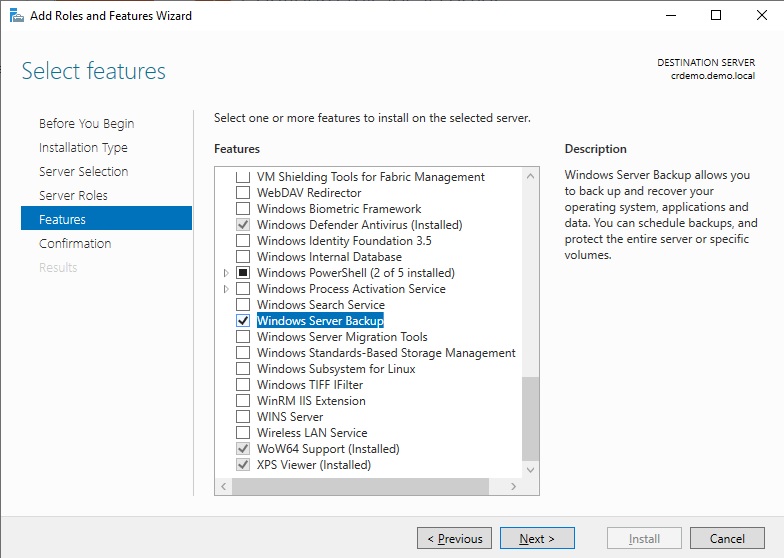
- At the Select features screen scroll down and click in the check box to the left of “Windows Server Backup” and click Next >
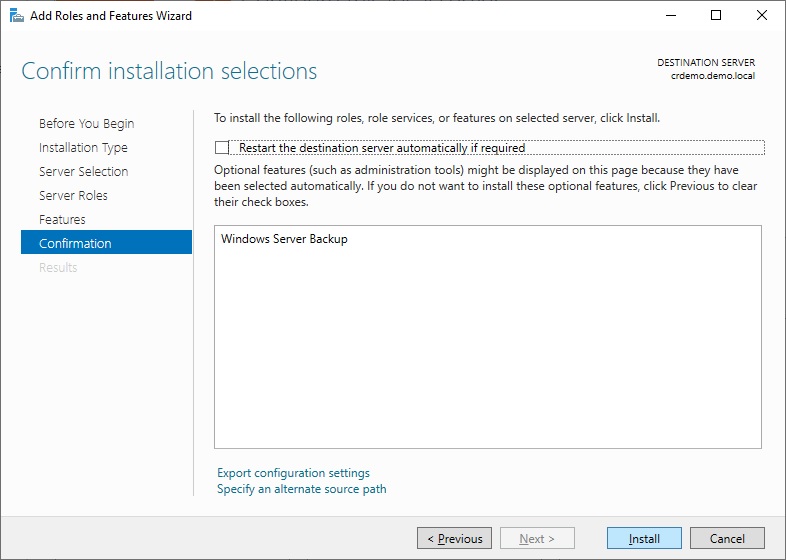
- On the Confirm Installation Selections window click Install.
- At the Before you begin screen click Next >
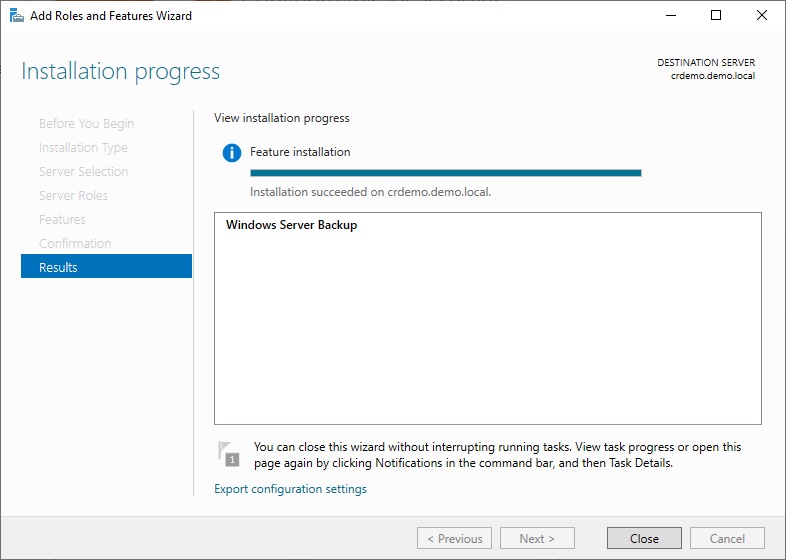 Once Windows Server Backup has finished installing, we will now configure a backup of our Windows 2019 Server
Once Windows Server Backup has finished installing, we will now configure a backup of our Windows 2019 Server
Step 2 – Schedleing backup of the server.
I cannot imagine a more nightmarish scenario than losing your Active Directory Domain Server. Not only would this cause your organization to grind to a halt, but you would be looking at many hours to rebuild your AD/DS server, populate your data, etc. Not to mention you will also have to rebuild your Exchange Server if you have one of those, due to how integrated Exchange is to Active Directory. So would be a good idea to make sure you have good backups of this critical server. We will show you how with Windows Server Backup.
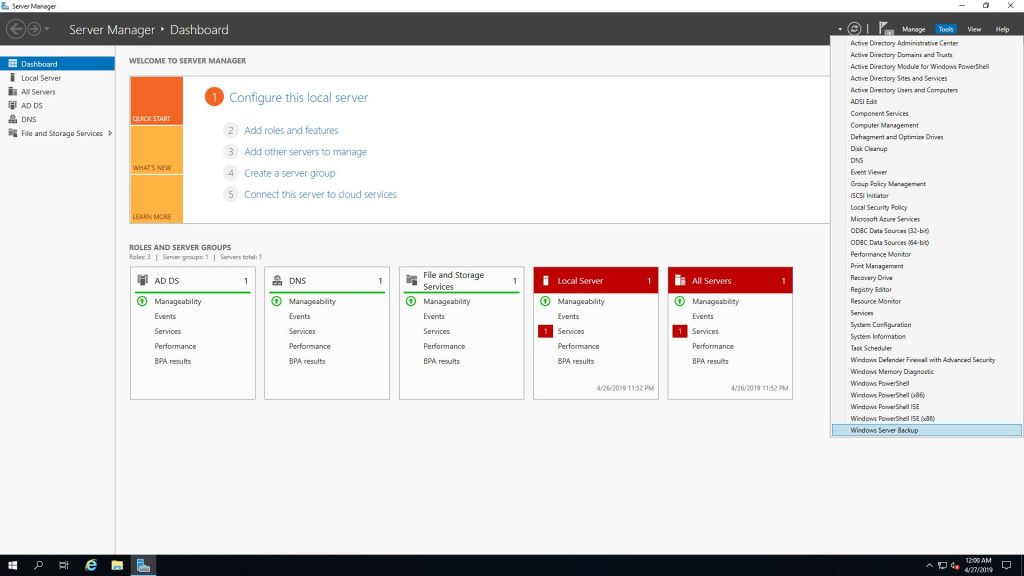 From the Server Manager Dashboard, Select Tool > Windows Server Backup
From the Server Manager Dashboard, Select Tool > Windows Server Backup
Under windows Server Backup (Local) right click Local Backup, and click Backup Schedule…
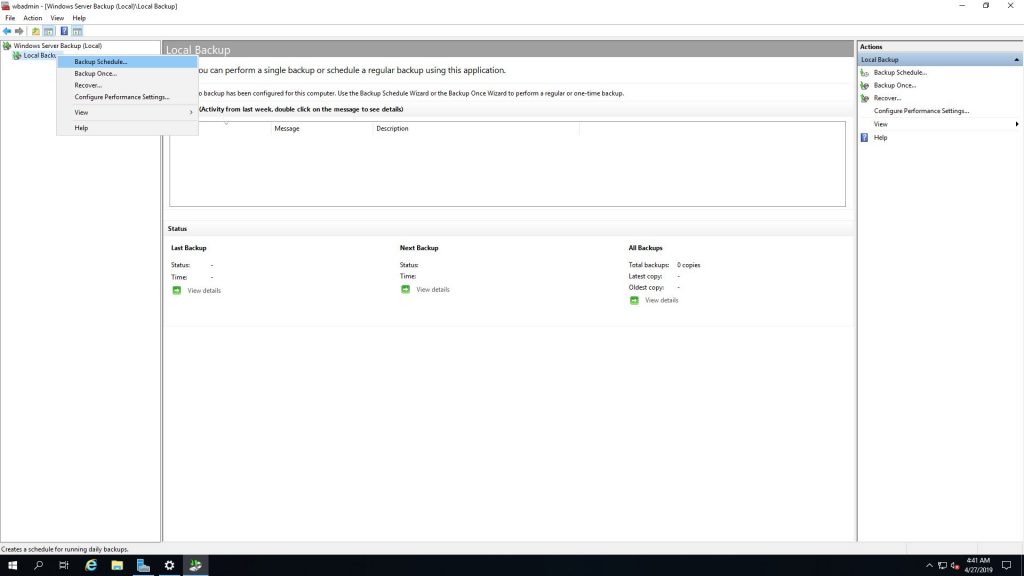 The Backup Schedule Wizard will launch.
The Backup Schedule Wizard will launch.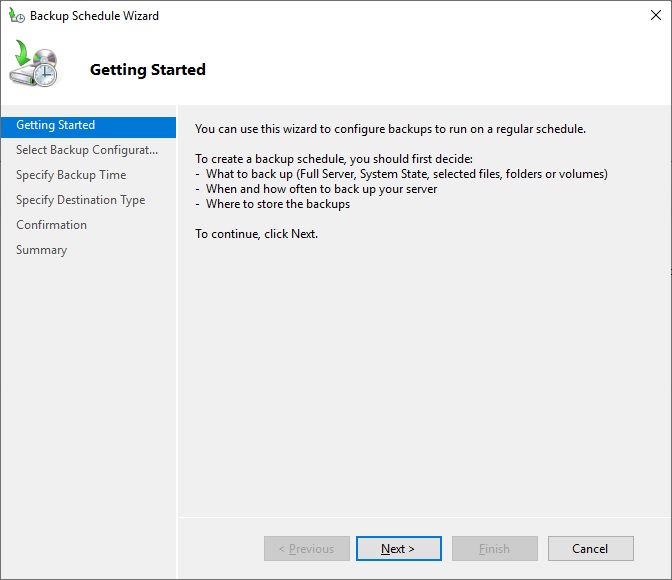
-
- Click Next
- Select the ‘Custom’ option and click Next >
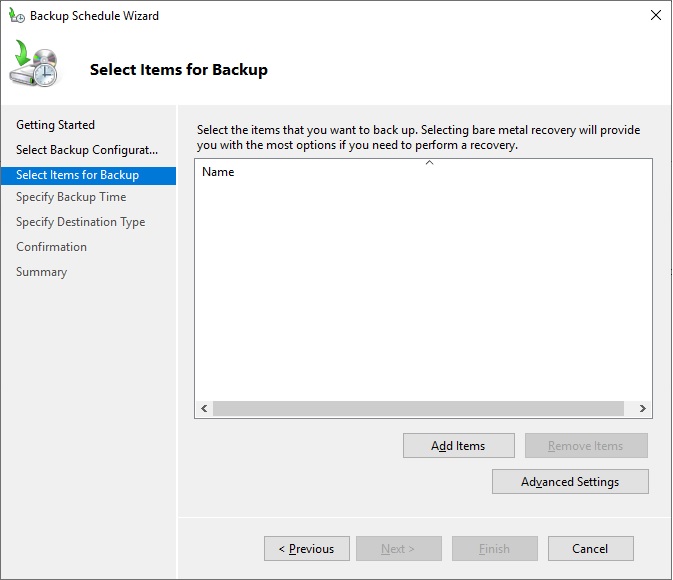
- Click Add Items
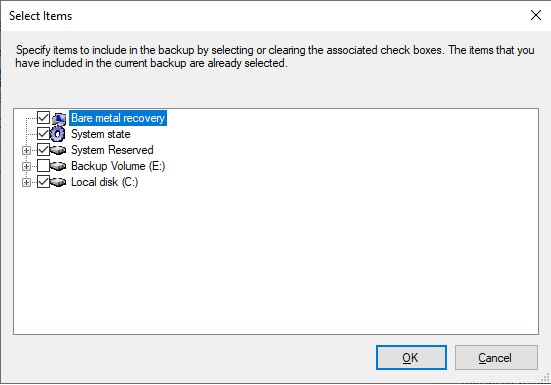
- Select the ‘VSS Settings’ tab.
- Click the ‘VSS full backup’ option (This is IMPORTANT for AD/DS Severs and Microsoft Exchange Servers). See the note on Microsoft Exchange Servers at the end of this section for more details.
- Click OK
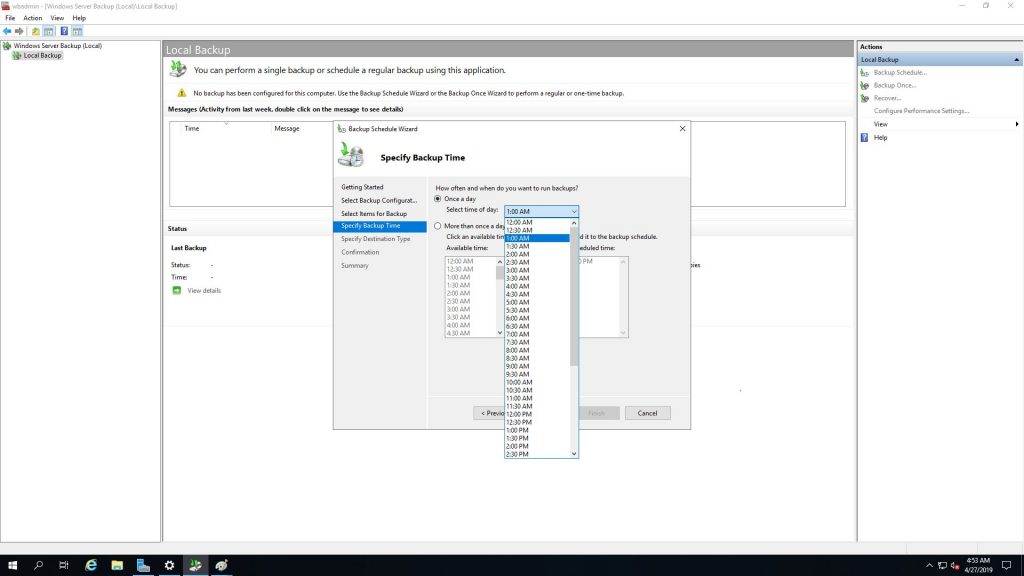
- Next, we will specify a backup time, (Once a day at 9pm is the default.)
For this demo we are using a dedicated backup volume, so we will leave this option as is. This option will reformat the disk, so make sure it is either a new disk or one you do not have any important data you wish to keep. If you are backing up a hard disk that is used to store other data besides a backup you would select “Backup to a volume.”, if you are backing up to a network share use the “Back up to a shared network folder.” Click Next >.
As we are using an internal hard disk for this demo we must click ‘Show All Available Disks.’
-
- Click the disk you wish to place the backups; in this case I am selecting the 80GB volume E:\
- Click OK
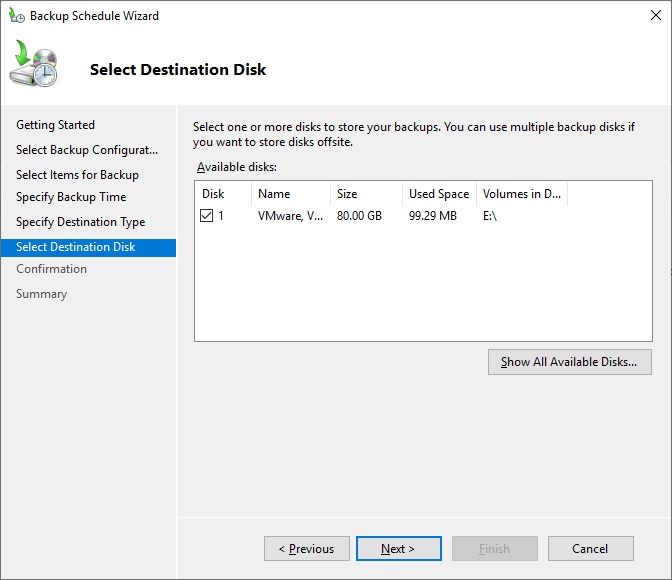
- Select the Disk again in the Select Destination Disk Window and click Next.
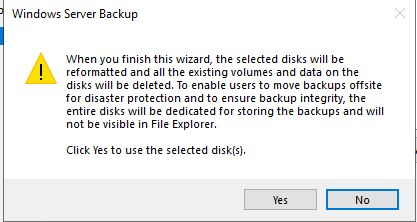
- Click Yes to the warning the disk will be reformatted.
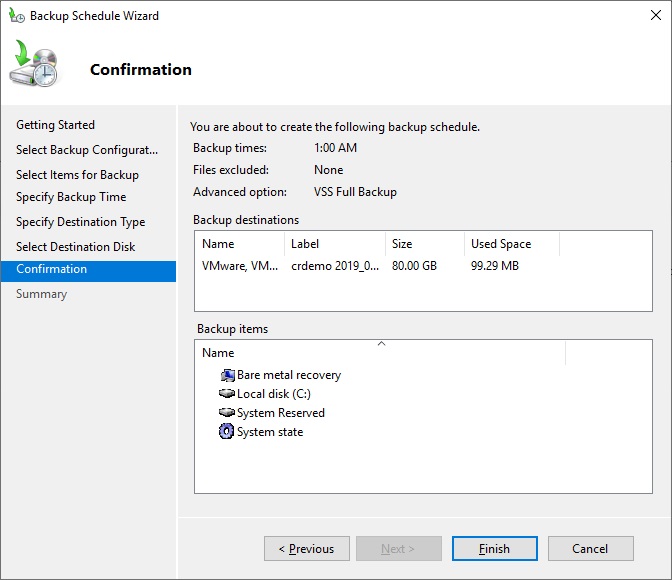
- You will then see the following confirmation screen.
- Once the backup schedule has been successfully created, click the Close Button.
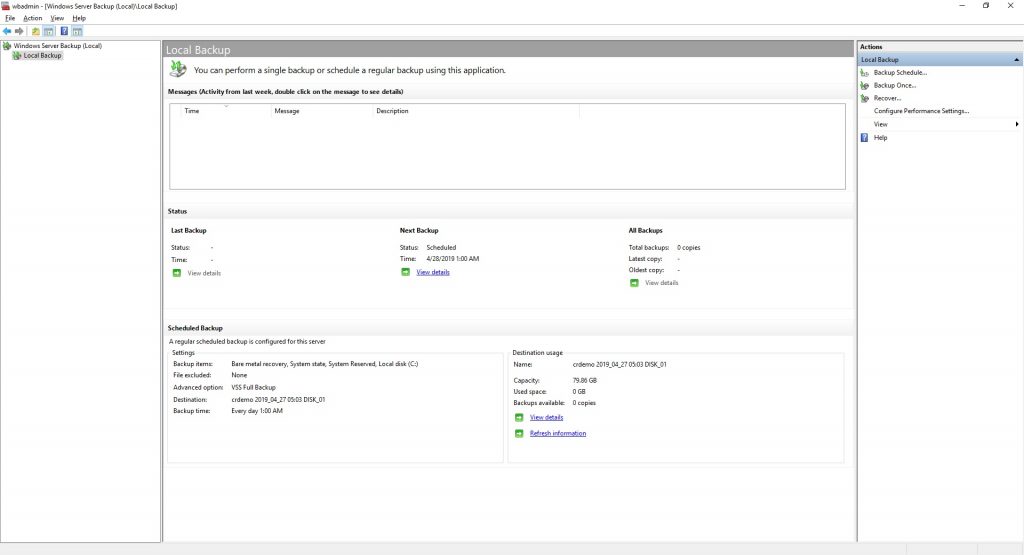 You will now see your backup schedule here, showing the status of the previous backup, the next backup scheduled, a summary of ALL backups performed.
You will now see your backup schedule here, showing the status of the previous backup, the next backup scheduled, a summary of ALL backups performed.
Let’s also go over some notes regarding Windows Server Backup.
When backing up a Microsoft Exchange Server, the Exchange transaction journals will automatically be deleted, if you notice that the files are not being deleted off your Exchange Server, this is indicative of either a failed backup, or no backup being performed.
If your server hosts a database such as Microsoft SQL Server, or MariaDB (MYSQL), you will want to exclude the volume or directory the database resides on, and use a database aware backup solution. While you can use Windows Server backup to backup these databases, as the database is constantly being written to, this will make your incremental backups larger than necessary.
To recap, it is extremely important that you perform backups of your servers to maintain the availability of your data. There are many tools available both commercial and free. We have demonstrated setting up a daily backup schedule of a Windows 2019 Active Directory Domain Server AD/DS using Windows Server Backup, as well as discussed, the caveats for a Microsoft Exchange or database applications server.
Next month I will preset backing up a Linux server using Backula, as well as how to create a Image of the Operating System and a MariaDB SQL database dump using tools from the command line. I hope you enjoyed this month’s technical tutorial, and will continue to visit Brent’s World for new content. If you wish to receive an email when new content is posted, you may registered by CLICKING HERE!

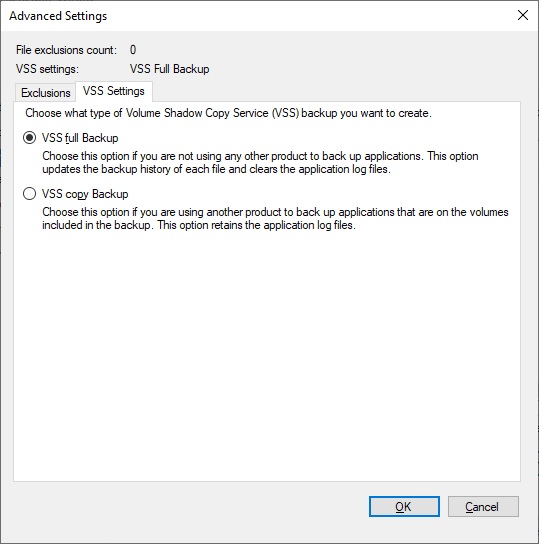
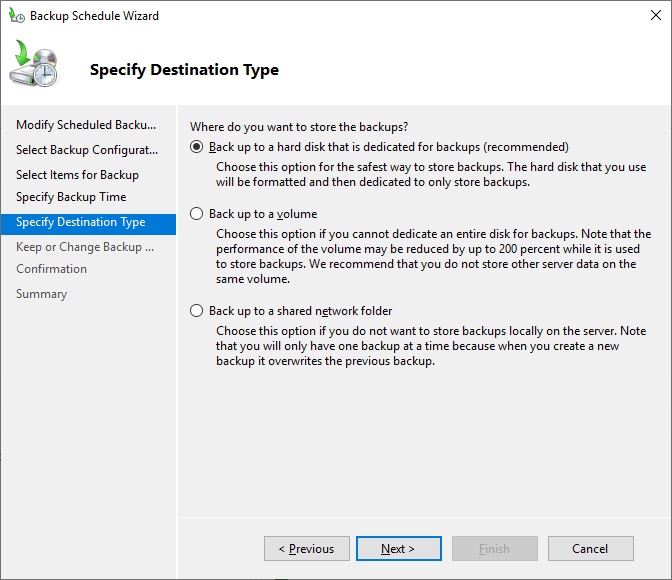
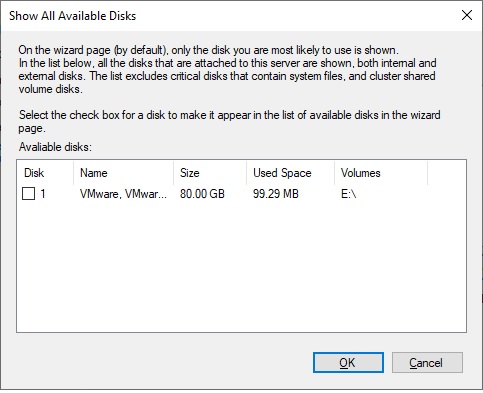
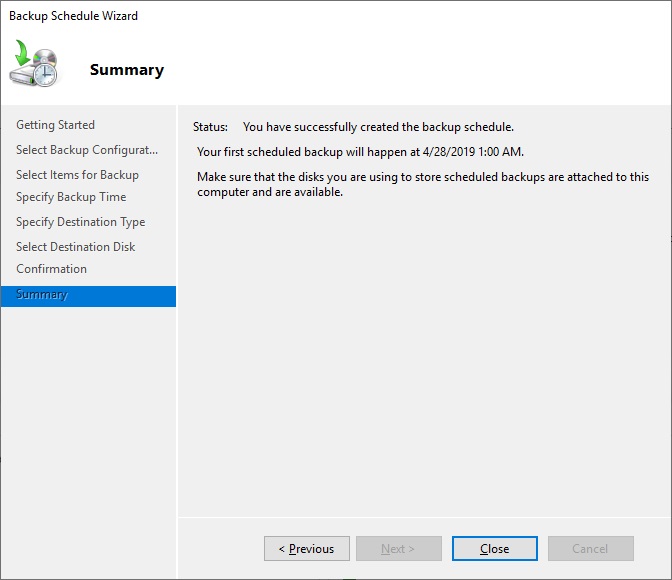
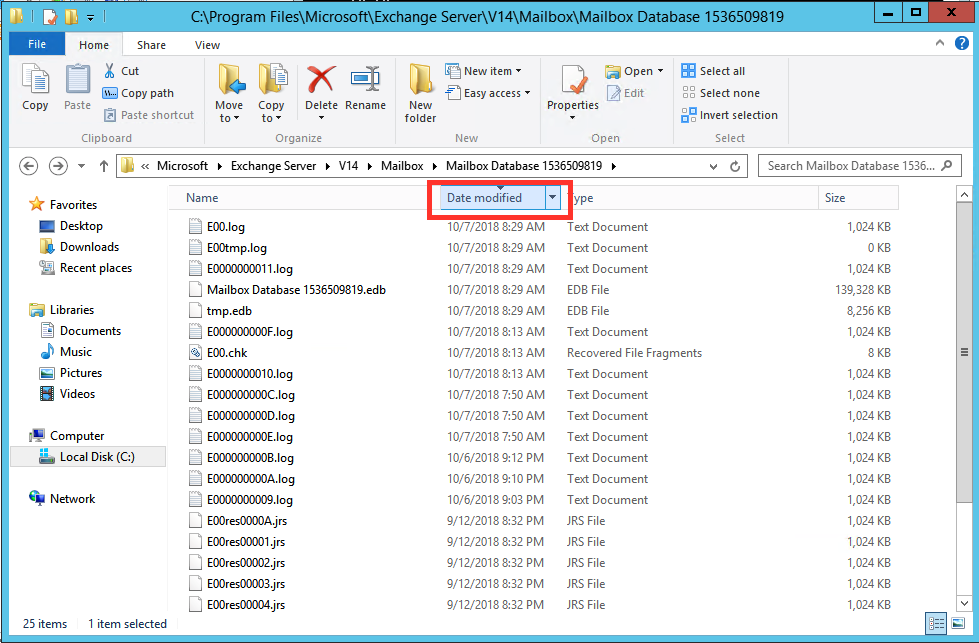
Comments
Technical – The Proverbial Second Chance (Backup your stuff!) — No Comments
HTML tags allowed in your comment: <a href="" title=""> <abbr title=""> <acronym title=""> <b> <blockquote cite=""> <cite> <code> <del datetime=""> <em> <i> <q cite=""> <s> <strike> <strong>